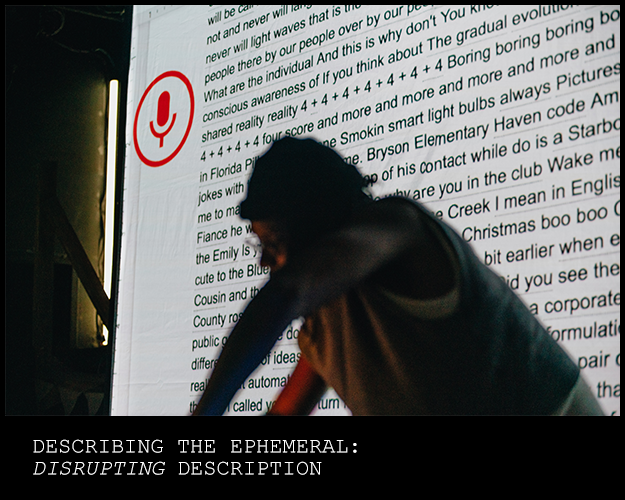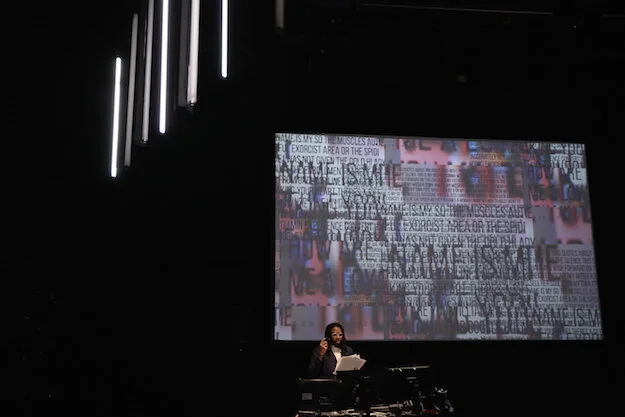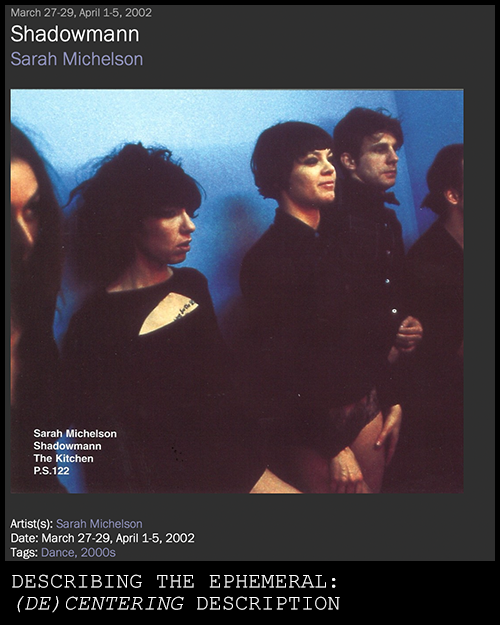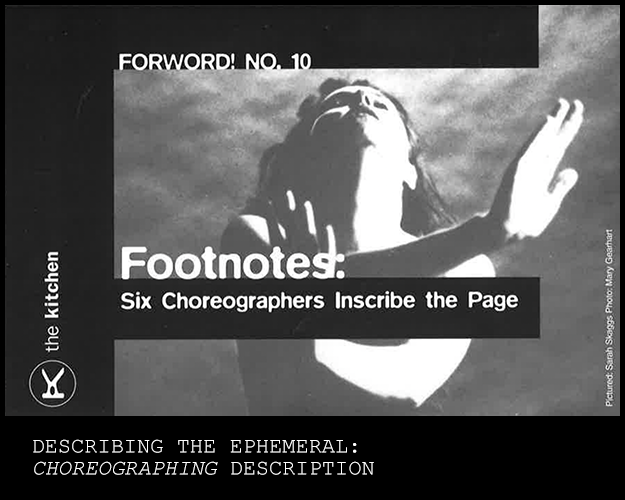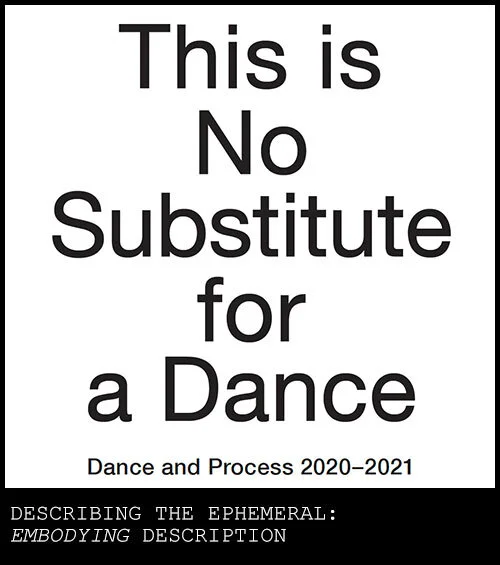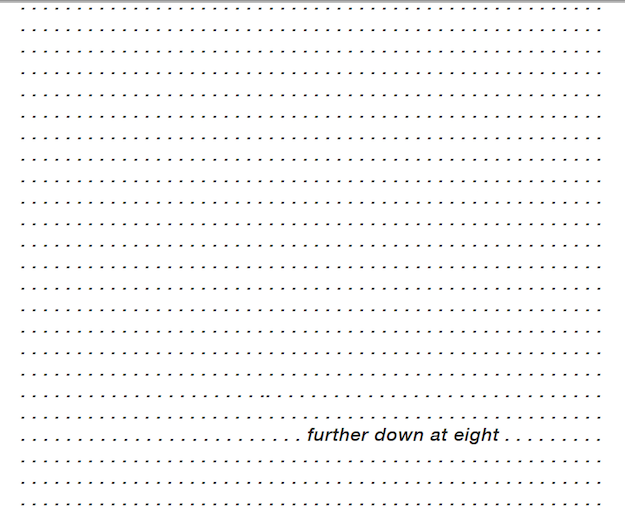Describing the Ephemeral
By Maryam Rahaman and Noa Rui-Piin Weiss, Summer 2021 Curatorial Interns
The Archival Highlight project was conceived as a platform for The Kitchen’s Curatorial interns to develop their own lens through which to consider The Kitchen’s vast archive and share their findings with its audiences on Instagram. From July 22–September 8, 2021, we (Maryam Rahaman (@mimi_on_marz) and Noa Rui-Piin Weiss (@weiss.soserious) formed a project thesis, researched events from The Kitchen’s history, gathered archival materials, and prepared highlights for social media.
When we received the task of a series highlighting a particular theme within the archives, we were given free rein over which materials we would examine. The size of The Kitchen’s archival collection was daunting at first, but we collaborated to unearth common themes in our research interests to home in on a mutual focus. Description stuck out as a critical aspect of examining archives—the medium where language and experience rub against each other, forming new ways to preserve the past. The archive is full of secondary materials: promotional documents and writing about performances and installations that cannot be recorded or replicated. We settled on the theme Describing the Ephemeral, a title that was capacious enough for us to explore our separate interests and to find the overlap.
As we began our research and checked in with the curatorial team for feedback, we started to understand that each staff member has individual areas of expertise within The Kitchen’s archive. Given that The Kichen’s vast archive spans fifty years of programming, no one person can be familiar with all of the materials. Instead we realized that everyone who dives into the archive becomes their own kind of expert. Each researcher’s archival interaction is guided by personal memories and connections. Alongside The Kitchen’s institutional archive is an attached web of memories, relationships, and free-associated connections. To explain our own guiding questions and personal knowledge, here is some context from each of us individually.
From Maryam: I am really interested in how The Kitchen as a space takes the at-times confining, and usually text-based, world of literature and expands it past its traditional uses. I have a strong personal love of books, texts, and novels, and I am keenly interested to see how words can jump off the page in new ways. The loosely literature-based events that we selected for this series—and The Kitchen’s literature programming more broadly—each spoke to some aspect of this. Revisiting these pieces really made me question what literature is, especially when lines become blurred. When performance is integral to a written text, what does it mean to read the text without the context of the performance? I don’t believe that there’s an answer to any of this. But the experimentations of different artists will certainly inspire me to seek out performances that risk warping the definition of text-based work.
From Noa: When it comes to the archive, I always start with what’s familiar, beginning with artists and companies that I have researched before. My interactions with archives intertwine with my dance training—while I work at different organizations, I’m engaging in a long term parallel project to acquire a holistic understanding of New York City experimental dance history. As I track artists across institutions, I’m beginning to understand how artists are beginning to learn from archival methods and incorporate them into their careers. Catching a live performance is rare, and it becomes necessary to create other means of engaging with a show. An artists’ dance practice is primarily captured through ephemera—the traces they leave online to build their legitimacy and artistic persona. Describing and packaging your own dance practice is a method to reaffirm its existence in the present, and ensure its traceability in the future. Describing the Ephemeral is a type of labor that dance artists practice frequently, revealing the archive to be an essential part of the long-term arc of this time-based medium.
The text and images below first appeared as posts on Instagram over the course of seven weeks. To view the full series in its original context, please explore #DescribingTheEphemeral.
Advertisement for Christopher Knowles, A Typing Work Show, May 1976.
May 1976 calendar of programming, The Kitchen.
ARCHIVAL HIGHLIGHT #1: Visualizing Description
In May 1976, Christopher Knowles showed a text-based exhibition entitled A Typing Work Show alongside the then newly created theatrical work A Solo Piece. Often known for his collaborations with artists such composer and Kitchen Board member Philip Glass (@philipglassmusic) and theater director Robert Wilson (@watermillcenter) Knowles is a poet and visual artist who has played with the visual and aural capacities of language for decades. A Typing Work Show is one of the earliest examples of Knowles’s interest in language. The exhibition featured poems, songs, Knowles’s signature typed designs, and videotapes made on devices that produce animated text; prompting audiences to consider text-based pieces as simultaneously written and visual artworks.
One might think that it would be easier to archive text-based art. However, the currently available documentation of the show leaves us with questions about what exactly these visual pieces looked like: materials in The Kitchen’s web archive are text-based rather than photographic. Still, the programming calendar and advert included here may be helpful as we recall the textual aesthetics of the seventies and Christopher Knowles’ early explorations. What can we gain from imagining these works unadulterated by images?
Postcard for Talking Dance at The Kitchen, January–February, 2001. Front and back.
Gia Kourlas, “Movement Leavened With Language,”The New York Times, January 28, 2001.
ARCHIVAL HIGHLIGHT #2: Performing Description
Can language and dance ever get along? Talking Dance, a two part performance series curated by Dean Moss, aimed to combat the myth dance and language are inherently at odds.
Talking Dance brought together two programs of experimental dance: one full of ’60s post-modern icons, and another with early-mid career choreographers working within the same legacy. Lucy Sexton and Anne Iobst of Dancenoise hosted both shows, and post-show panels were moderated by scholar Maura Keefe.
Reviews from Wendy Perron (@wendy72perron), Gia Kourlas (@giadk), and Jack Anderson recount a mixed bill of interpretations. In Accumulation With Talking Plus Water Motor, Trisha Brown spoke about making dances as she performed a piece of her choreography. Blondell Cummings paired her moving body with recordings of middle-aged women talking about aging. Miguel Gutierrez (@aboylikethat), true to form, performed a talking dance about talking dance titled It’s Time for Another One of Those Crazy Talking Dances in collaboration with Sarah Michelson.
Many of the artists let the relationship between description and dance remain contentious. As an ephemeral form, dance often eludes language. Yet, what remains of Talking Dance are not the gestures performed, or the words the artists used. The language most tied to these dances are the reviews that describe the work in the grace period between performance and archiving. Descriptions created through experiencing the performance form the most enduring connection between dance and language.
Program 1: Ann Carlson, Blondell Cummings, Douglas Dunn, David Gordon, Bill T. Jones, and Yvonne Rainer
Program 2: Katie Duck, Elevator Repair Service, Foofwa d’Imobilité, Miguel Gutierrez, Sarah Michelson, Cynthia Oliver, and Jamie Sneider
James Allister Sprang. Photo by E. Aaron Ross.
Concret poem by James Allister Sprang, as part of Turning Towards a Radical Listening, 2019.
James Allister Sprang, Turning Towards a Radical Listening, October 5–26, 2019. Performance view, The Kitchen. Photo ©2019 Paula Court.
Satchel Spencer, app design for James Allister Sprang.
ARCHIVAL HIGHLIGHT #3: Disrupting Description
Listening has long been applauded as a cornerstone of communication. But when we insert technology into our lives—and computing bodies rather than organic ones are the listeners—how does communication change? How is it distorted?
James Allister Sprang’s (@jamesallistersprang) Turning Towards a Radical Listening explored these questions over a five-week residency at The Kitchen in October 2019. The project began with conversations between Sprang and poets M. NourbeSe Philip, Rachel Eliza Griffith, and Tracie Morris on the role of language in our lives. These conversations were recorded, composed by Sprang, and subsequently ran through voice-to-text software to create a series of live sound-based sculptural installations and performances. Each performance generated poems which challenged audiences to view how AI technology distorts and reappropriates language, and immersed viewers in a sonic landscape to consider “how changes in listening may yet act as a catalytic force in culture.”
Although it was important to the artist for audiences to experience the work live with its layers of audio and expansive visuals, many digital materials afford us the opportunity to revisit the work. In addition to a pre-residency interview with Sprang, there are: photographs of the show that visually place us alongside Sprang’s audience; “concret poem” of the various lines of text, allowing us to also consider the questions of AI and language; and “digital drawings” created for Sprang by Satchel Spencer in response to the AI-generated poems.
Which of these materials allow you to engage with the work most deeply, as either someone new to this work or as someone revisiting?
Postcard for Sarah Michelson, Shadowmann at The Kitchen, April 1–5, 2002. Front.
Laura Shapiro, “Site Lines,” New York Magazine, April 24, 2003.
Postcard for Sarah Michelson, Shadowmann at The Kitchen, April 1–5, 2002. Back.
Description of Sarah Michelson, Shadowmann, published on archive.thekitchen.org.
ARCHIVAL HIGHLIGHT #4: (De)centering Description
Sarah Michelson (#SarahMichelson) is not interested in creating her own ephemera. Her philosophy: live dance reigns above all. Everything else—programs, reviews, videos—is secondary.
But even in light of the artist’s desire to center only the live experience, additional materials still find a way in. In the world of live performance, external descriptions traditionally play a role in how work is shared with larger audiences and how artistic practices are traced over time, even though they cannot replace the work they aim to publicize. With little photo of video documentation available, fans unable to experience her performances often choose to seek out whatever descriptions are available to engage with.
This post contains three pieces of description surrounding Michelson’s 2002 piece Shadowmann, performed in two parts at The Kitchen and P.S. 122:
- A quotation from a review by Laura Shapiro for New York Magazine (@nymag). The review goes on to describe the work, with the caveat that this is not how audience members are meant to encounter the dance.
- The Shadowmann program note. This description, most likely written by Michelson, gives the reader few clues as to the shape or style of the piece. Like much of Michelson’s choreography, it is cryptic and self-referential, to be enjoyed and not necessarily understood.
- Description of Shadwomann written by Summer 2021 Curatorial Intern Noa Rui-Piin Weiss (@weiss.soserious) for The Kitchen’s Archive database. “My main goal was to make this piece as searchable as possible. Although the dancers’ names are included in the program (also linked on the archive website), I added them here to increase the likelihood that they would be found. My former dance teacher, Jennifer Howard, performed in this piece. Over the years, I have tried to find traces of the works she performed in, especially those by Sarah Michelson. This description pulls entirely from secondary sources, as I have never seen the dance.”
Video still from recording of The Kitchen L.A.B. with Andrea Geyer, Sarah Schulman, and James Allister Sprang, December 3, 2019 at The Kitchen. Videography by Iki Nakagawa.
Selection of text picked by James Allister Sprang ahead of the December 3, 2019 L.A.B. discussion.
Selection of text picked by Andrea Geyer ahead of the December 3, 2019 L.A.B. discussion.
Selection of text picked by Sarah Schulman ahead of the December 3, 2019 L.A.B. discussion.
ARCHIVAL HIGHLIGHT #5: Layering Description
How do our own experiences as artists, archivists, and audience members create relationships not only with art but with each other? How does revisiting art with others create new shared or individual understandings?
The Kitchen’s L.A.B. program with Andrea Geyer (@andreageyer2), James Allister Sprang (@jamesallistersprang), and Sarah Schulman (@schulmanny) is one example of how our experiences with performance and art are revitalized through conversation and connection. “Regeneration” served as the guiding term for the evening. From Geyer’s explicit reference to filmmaker Chantal Akerman’s words or Schulman’s compilation of the personal histories of AIDS activists, the artists discussed stories, people, and inspirations that continue to shape their work, effectively sharing their lives with the audience as well.
The format of the L.A.B. discussions (which stands for language, art, bodies) served this idea of regeneration quite well. All events in the ongoing series are open to the public, and full recordings are posted online afterwards, creating an unending space for artists and audience members alike to build connections through art. The choice to title this post “Layering Description'' comes from Geyer’s idea of “layers” of art. As works are revisited, referenced, and discussed, they gain new meaning and allow us the chance to build community. The highlight series is yet another example of this—even social media can be used to revisit performances and consider them in a new light. We invite you to revisit this L.A.B discussion (available on Vimeo) and reflect on how new “layers” impact your relationship to familiar works of art.
Postcard for Footnotes: Six Choreographers Inscribe the Page at The Kitchen, October 20, 1998. Front.
Program for Footnotes: Six Choreographers Inscribe the Page at The Kitchen, October 20, 1998.
ARCHIVAL HIGHLIGHT #6: Choreographing Description
What happens when choreographers try to capture writing as a form of choreography?
Footnotes: Six Choreographers Inscribe the Page (1998) was an evening of dance centered around an anthology of the same title compiled by Elena Alexander. The book, published the same year, gave a group of choreographers a chance to produce writing as dancemakers. The performance of Footnotes served as both a literary event and a performance to celebrate the publication of the anthology.
Douglas Dunn (@dunndance), Marjorie Gamso, Ishmael Houston-Jones (@ishmaelhoustonjones), Kenneth Kings, Yvonne Meier (@ymeier01), and Sarah Skaggs (@sarah_j_skaggs) each took distinctive pathways to move between choreography and writing. The structure of the performance mirrored the table of contents of the book, including a foreword by Jill Johnston and commentary by Alexander.
Although Alexander intentionally centered dance throughout the anthology and the event, the writing has prevailed. Search results for Footnotes are dominated by links to purchase the book rather than programs or recordings of the performance. rather than recordings of performances. Artists can place choreography and description on equal footing in performance, but commerce often creates its own archive around the forms that can be bought and sold.
Excerpts from Dance and Process 2020–2021 publication, This is No Substitute for a Dance, 2021.
ARCHIVAL HIGHLIGHT #7: Embodying Description
How can a description become an ephemeral embodied experience?
Built from monthly entries on The Kitchen OnScreen, The Dance and Process 2020–2021 cohort’s collaborative publication This is No Substitute For a Dance explored and exposed the creative process of dancemakers turning to new mediums in the midst of the pandemic. The excerpts featured here are from Kennis Hawkins (@kennishawkins), who offered a series of text-based somatic scores.
Much like a dance performance, these texts require a live participant to activate the piece. Hawkins uses the time-based process of reading to create a sequential physical experience for the reader—the familiar codes of ellipses and line breaks signal pauses, giving the audience a chance to embody the score. The choreographer becomes a writer, as the viewer becomes both a reader and a performer. The artists have clearly stated that this publication cannot replace a dance, but these descriptions have formed their own style of performance.
Dance and Process 2020–2021 included Leslie Cuyjet (@el_cuyjet), Kennis Hawkins (@kennishawkins), Kristopher K.Q. Pourzal, and Alex Rodabaugh (@alexrodabaugh), and was curated and facilitated by Moriah Evans (@mosnave) and Yve Laris Cohen (@yvelariscohen). The publication was designed by Sean Yendrys (@seanyendrys) and edited by Alison Burstein and Kathy Cho. Dance In Process culminated in a set of six online entries alongside two print publications, as well a series of in-person and livestreamed performances in May 2021.





